2005 PONTIAC BONNEVILLE check engine
[x] Cancel search: check enginePage 86 of 438
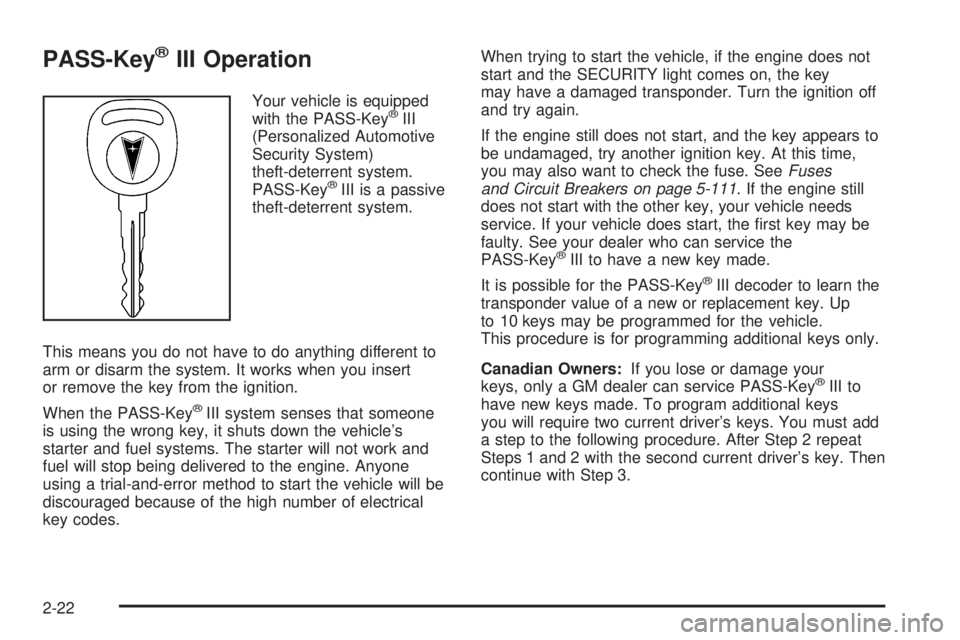
PASS-Key®III Operation
Your vehicle is equipped
with the PASS-Key®III
(Personalized Automotive
Security System)
theft-deterrent system.
PASS-Key
®III is a passive
theft-deterrent system.
This means you do not have to do anything different to
arm or disarm the system. It works when you insert
or remove the key from the ignition.
When the PASS-Key
®III system senses that someone
is using the wrong key, it shuts down the vehicle’s
starter and fuel systems. The starter will not work and
fuel will stop being delivered to the engine. Anyone
using a trial-and-error method to start the vehicle will be
discouraged because of the high number of electrical
key codes.When trying to start the vehicle, if the engine does not
start and the SECURITY light comes on, the key
may have a damaged transponder. Turn the ignition off
and try again.
If the engine still does not start, and the key appears to
be undamaged, try another ignition key. At this time,
you may also want to check the fuse. SeeFuses
and Circuit Breakers on page 5-111. If the engine still
does not start with the other key, your vehicle needs
service. If your vehicle does start, the �rst key may be
faulty. See your dealer who can service the
PASS-Key
®III to have a new key made.
It is possible for the PASS-Key
®III decoder to learn the
transponder value of a new or replacement key. Up
to 10 keys may be programmed for the vehicle.
This procedure is for programming additional keys only.
Canadian Owners:If you lose or damage your
keys, only a GM dealer can service PASS-Key
®III to
have new keys made. To program additional keys
you will require two current driver’s keys. You must add
a step to the following procedure. After Step 2 repeat
Steps 1 and 2 with the second current driver’s key. Then
continue with Step 3.
2-22
Page 89 of 438
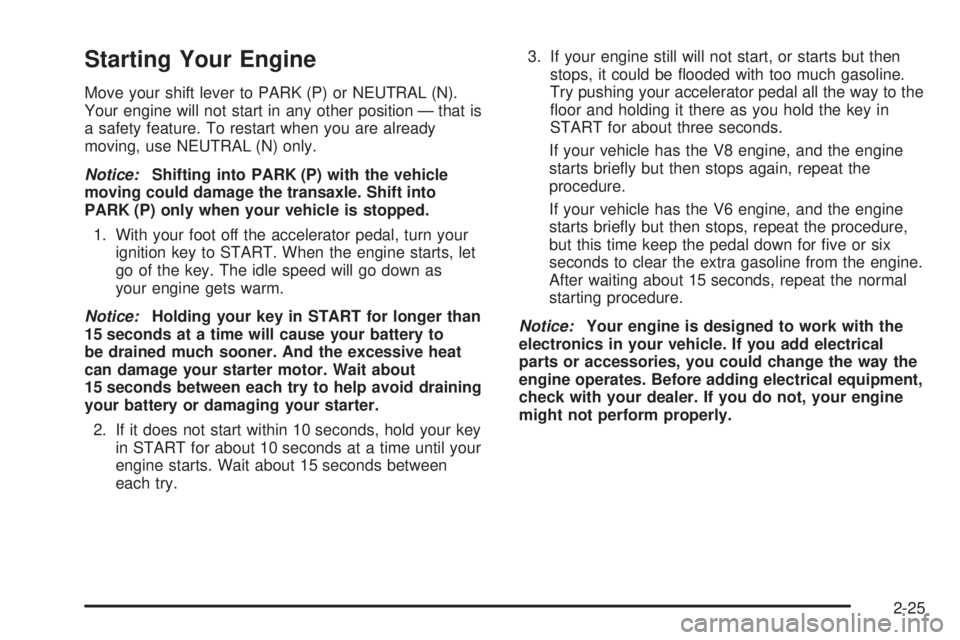
Starting Your Engine
Move your shift lever to PARK (P) or NEUTRAL (N).
Your engine will not start in any other position — that is
a safety feature. To restart when you are already
moving, use NEUTRAL (N) only.
Notice:Shifting into PARK (P) with the vehicle
moving could damage the transaxle. Shift into
PARK (P) only when your vehicle is stopped.
1. With your foot off the accelerator pedal, turn your
ignition key to START. When the engine starts, let
go of the key. The idle speed will go down as
your engine gets warm.
Notice:Holding your key in START for longer than
15 seconds at a time will cause your battery to
be drained much sooner. And the excessive heat
can damage your starter motor. Wait about
15 seconds between each try to help avoid draining
your battery or damaging your starter.
2. If it does not start within 10 seconds, hold your key
in START for about 10 seconds at a time until your
engine starts. Wait about 15 seconds between
each try.3. If your engine still will not start, or starts but then
stops, it could be �ooded with too much gasoline.
Try pushing your accelerator pedal all the way to the
�oor and holding it there as you hold the key in
START for about three seconds.
If your vehicle has the V8 engine, and the engine
starts brie�y but then stops again, repeat the
procedure.
If your vehicle has the V6 engine, and the engine
starts brie�y but then stops, repeat the procedure,
but this time keep the pedal down for �ve or six
seconds to clear the extra gasoline from the engine.
After waiting about 15 seconds, repeat the normal
starting procedure.
Notice:Your engine is designed to work with the
electronics in your vehicle. If you add electrical
parts or accessories, you could change the way the
engine operates. Before adding electrical equipment,
check with your dealer. If you do not, your engine
might not perform properly.
2-25
Page 114 of 438
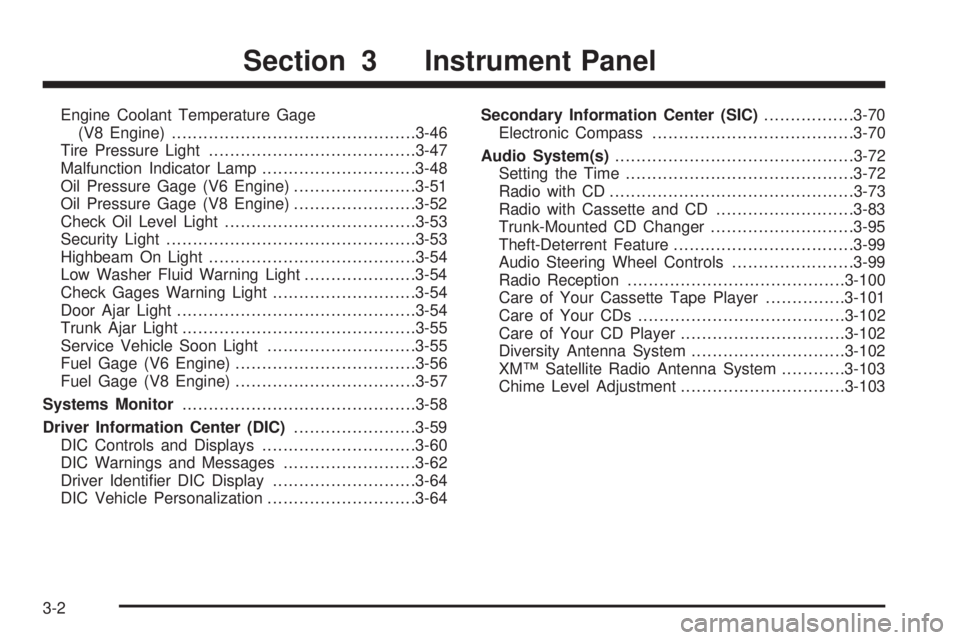
Engine Coolant Temperature Gage
(V8 Engine)..............................................3-46
Tire Pressure Light.......................................3-47
Malfunction Indicator Lamp.............................3-48
Oil Pressure Gage (V6 Engine).......................3-51
Oil Pressure Gage (V8 Engine).......................3-52
Check Oil Level Light....................................3-53
Security Light...............................................3-53
Highbeam On Light.......................................3-54
Low Washer Fluid Warning Light.....................3-54
Check Gages Warning Light...........................3-54
Door Ajar Light.............................................3-54
Trunk Ajar Light............................................3-55
Service Vehicle Soon Light............................3-55
Fuel Gage (V6 Engine)..................................3-56
Fuel Gage (V8 Engine)..................................3-57
Systems Monitor............................................3-58
Driver Information Center (DIC).......................3-59
DIC Controls and Displays.............................3-60
DIC Warnings and Messages.........................3-62
Driver Identi�er DIC Display...........................3-64
DIC Vehicle Personalization............................3-64Secondary Information Center (SIC).................3-70
Electronic Compass......................................3-70
Audio System(s).............................................3-72
Setting the Time...........................................3-72
Radio with CD..............................................3-73
Radio with Cassette and CD..........................3-83
Trunk-Mounted CD Changer...........................3-95
Theft-Deterrent Feature..................................3-99
Audio Steering Wheel Controls.......................3-99
Radio Reception.........................................3-100
Care of Your Cassette Tape Player...............3-101
Care of Your CDs.......................................3-102
Care of Your CD Player...............................3-102
Diversity Antenna System.............................3-102
XM™ Satellite Radio Antenna System............3-103
Chime Level Adjustment...............................3-103
Section 3 Instrument Panel
3-2
Page 145 of 438
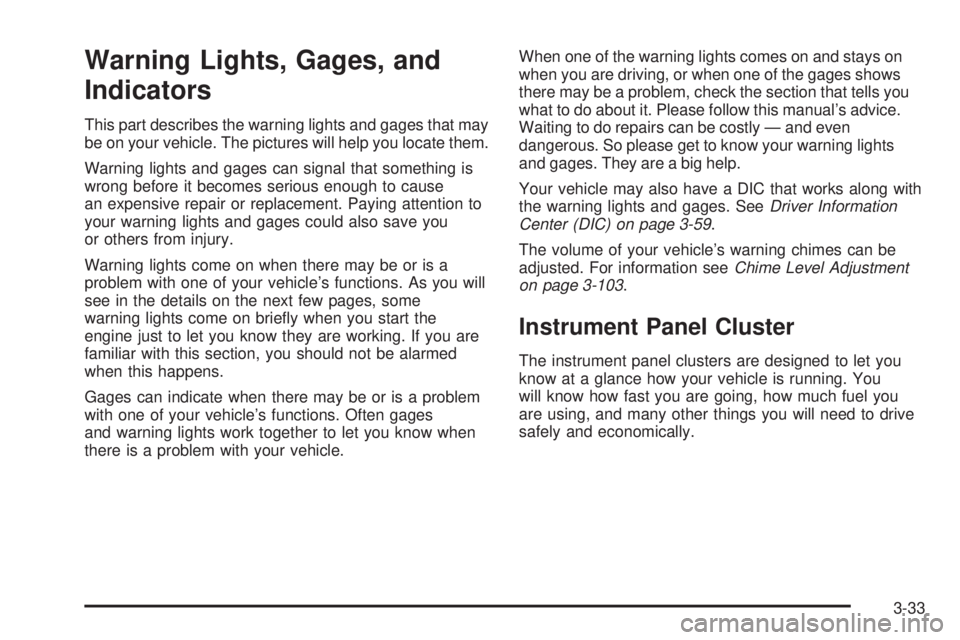
Warning Lights, Gages, and
Indicators
This part describes the warning lights and gages that may
be on your vehicle. The pictures will help you locate them.
Warning lights and gages can signal that something is
wrong before it becomes serious enough to cause
an expensive repair or replacement. Paying attention to
your warning lights and gages could also save you
or others from injury.
Warning lights come on when there may be or is a
problem with one of your vehicle’s functions. As you will
see in the details on the next few pages, some
warning lights come on brie�y when you start the
engine just to let you know they are working. If you are
familiar with this section, you should not be alarmed
when this happens.
Gages can indicate when there may be or is a problem
with one of your vehicle’s functions. Often gages
and warning lights work together to let you know when
there is a problem with your vehicle.When one of the warning lights comes on and stays on
when you are driving, or when one of the gages shows
there may be a problem, check the section that tells you
what to do about it. Please follow this manual’s advice.
Waiting to do repairs can be costly — and even
dangerous. So please get to know your warning lights
and gages. They are a big help.
Your vehicle may also have a DIC that works along with
the warning lights and gages. SeeDriver Information
Center (DIC) on page 3-59.
The volume of your vehicle’s warning chimes can be
adjusted. For information seeChime Level Adjustment
on page 3-103.
Instrument Panel Cluster
The instrument panel clusters are designed to let you
know at a glance how your vehicle is running. You
will know how fast you are going, how much fuel you
are using, and many other things you will need to drive
safely and economically.
3-33
Page 150 of 438
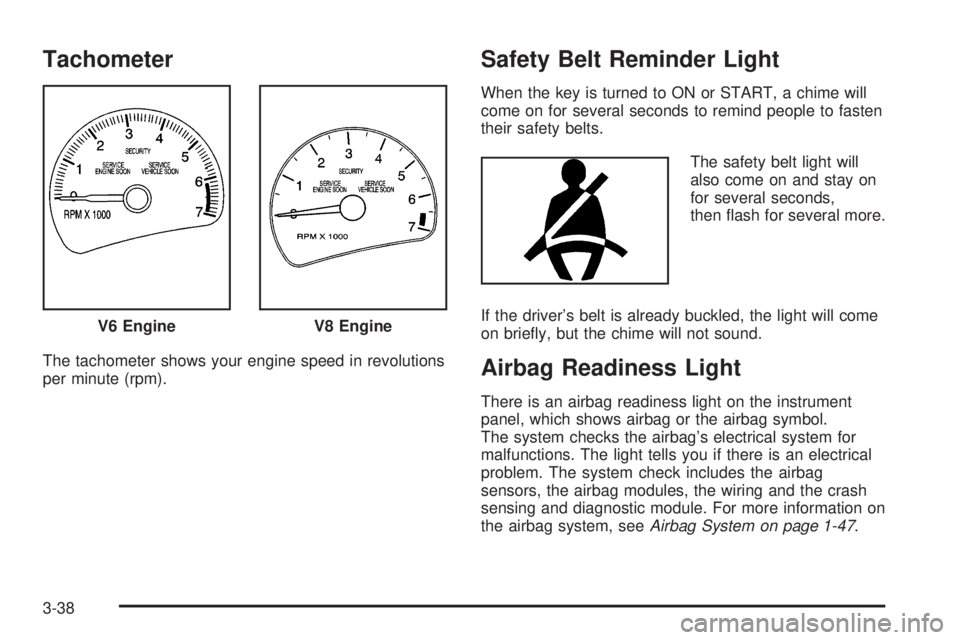
Tachometer
The tachometer shows your engine speed in revolutions
per minute (rpm).
Safety Belt Reminder Light
When the key is turned to ON or START, a chime will
come on for several seconds to remind people to fasten
their safety belts.
The safety belt light will
also come on and stay on
for several seconds,
then �ash for several more.
If the driver’s belt is already buckled, the light will come
on brie�y, but the chime will not sound.
Airbag Readiness Light
There is an airbag readiness light on the instrument
panel, which shows airbag or the airbag symbol.
The system checks the airbag’s electrical system for
malfunctions. The light tells you if there is an electrical
problem. The system check includes the airbag
sensors, the airbag modules, the wiring and the crash
sensing and diagnostic module. For more information on
the airbag system, seeAirbag System on page 1-47. V6 Engine
V8 Engine
3-38
Page 152 of 438
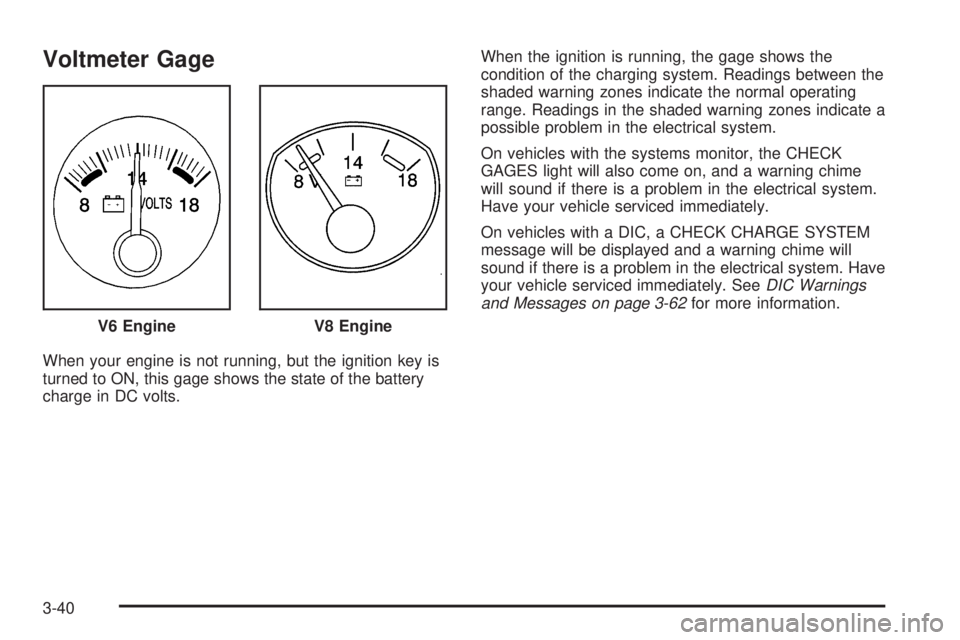
Voltmeter Gage
When your engine is not running, but the ignition key is
turned to ON, this gage shows the state of the battery
charge in DC volts.When the ignition is running, the gage shows the
condition of the charging system. Readings between the
shaded warning zones indicate the normal operating
range. Readings in the shaded warning zones indicate a
possible problem in the electrical system.
On vehicles with the systems monitor, the CHECK
GAGES light will also come on, and a warning chime
will sound if there is a problem in the electrical system.
Have your vehicle serviced immediately.
On vehicles with a DIC, a CHECK CHARGE SYSTEM
message will be displayed and a warning chime will
sound if there is a problem in the electrical system. Have
your vehicle serviced immediately. SeeDIC Warnings
and Messages on page 3-62for more information.
V6 Engine
V8 Engine
3-40
Page 157 of 438
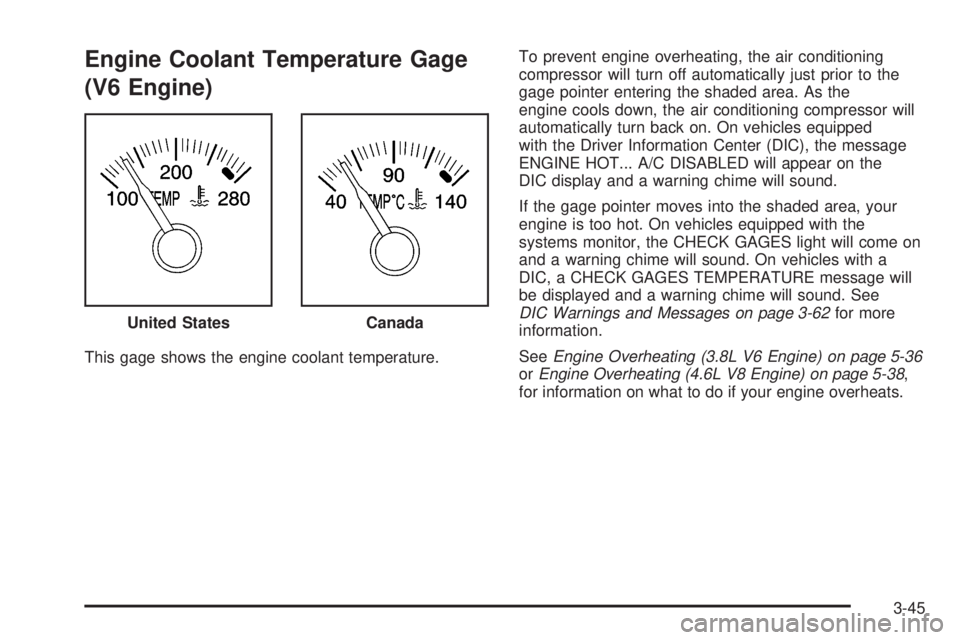
Engine Coolant Temperature Gage
(V6 Engine)
This gage shows the engine coolant temperature.To prevent engine overheating, the air conditioning
compressor will turn off automatically just prior to the
gage pointer entering the shaded area. As the
engine cools down, the air conditioning compressor will
automatically turn back on. On vehicles equipped
with the Driver Information Center (DIC), the message
ENGINE HOT... A/C DISABLED will appear on the
DIC display and a warning chime will sound.
If the gage pointer moves into the shaded area, your
engine is too hot. On vehicles equipped with the
systems monitor, the CHECK GAGES light will come on
and a warning chime will sound. On vehicles with a
DIC, a CHECK GAGES TEMPERATURE message will
be displayed and a warning chime will sound. See
DIC Warnings and Messages on page 3-62for more
information.
SeeEngine Overheating (3.8L V6 Engine) on page 5-36
orEngine Overheating (4.6L V8 Engine) on page 5-38,
for information on what to do if your engine overheats. United States
Canada
3-45
Page 158 of 438
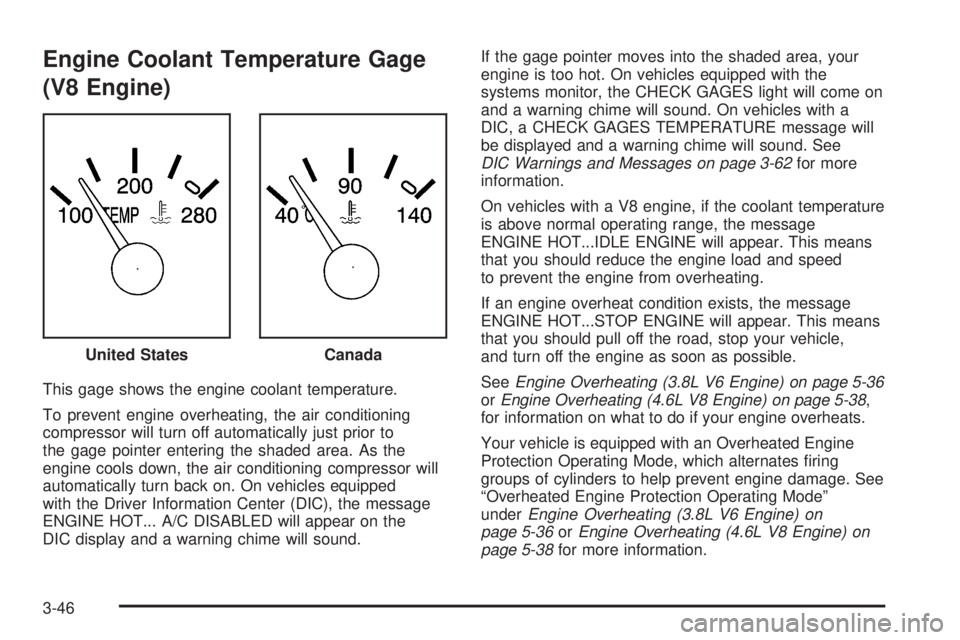
Engine Coolant Temperature Gage
(V8 Engine)
This gage shows the engine coolant temperature.
To prevent engine overheating, the air conditioning
compressor will turn off automatically just prior to
the gage pointer entering the shaded area. As the
engine cools down, the air conditioning compressor will
automatically turn back on. On vehicles equipped
with the Driver Information Center (DIC), the message
ENGINE HOT... A/C DISABLED will appear on the
DIC display and a warning chime will sound.If the gage pointer moves into the shaded area, your
engine is too hot. On vehicles equipped with the
systems monitor, the CHECK GAGES light will come on
and a warning chime will sound. On vehicles with a
DIC, a CHECK GAGES TEMPERATURE message will
be displayed and a warning chime will sound. See
DIC Warnings and Messages on page 3-62for more
information.
On vehicles with a V8 engine, if the coolant temperature
is above normal operating range, the message
ENGINE HOT...IDLE ENGINE will appear. This means
that you should reduce the engine load and speed
to prevent the engine from overheating.
If an engine overheat condition exists, the message
ENGINE HOT...STOP ENGINE will appear. This means
that you should pull off the road, stop your vehicle,
and turn off the engine as soon as possible.
SeeEngine Overheating (3.8L V6 Engine) on page 5-36
orEngine Overheating (4.6L V8 Engine) on page 5-38,
for information on what to do if your engine overheats.
Your vehicle is equipped with an Overheated Engine
Protection Operating Mode, which alternates �ring
groups of cylinders to help prevent engine damage. See
“Overheated Engine Protection Operating Mode”
underEngine Overheating (3.8L V6 Engine) on
page 5-36orEngine Overheating (4.6L V8 Engine) on
page 5-38for more information. United States
Canada
3-46